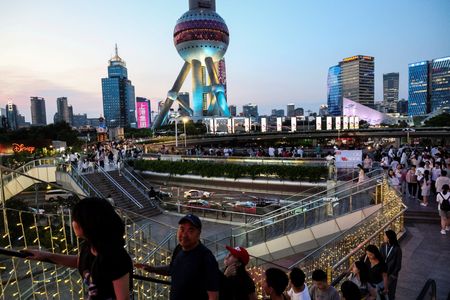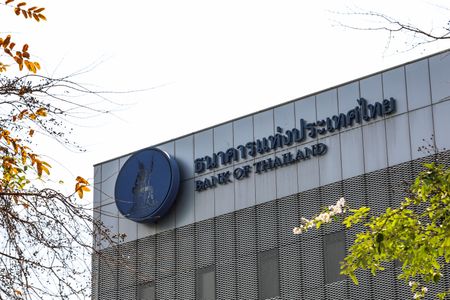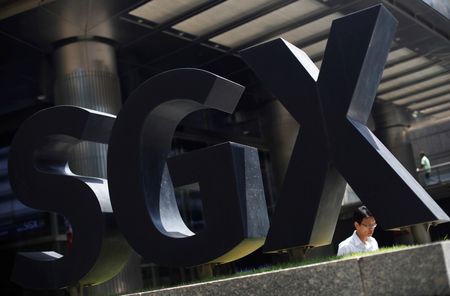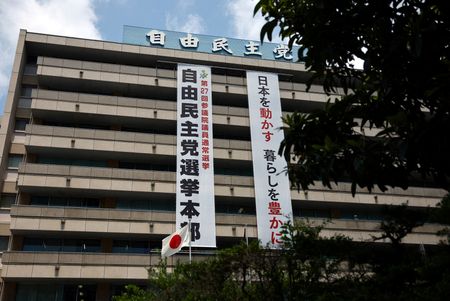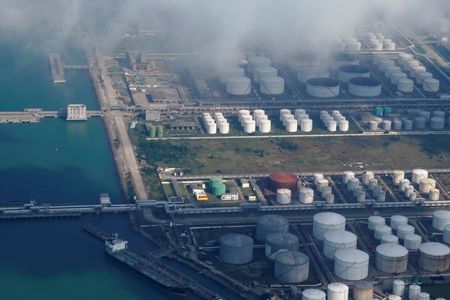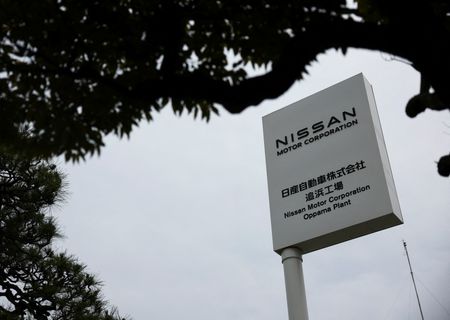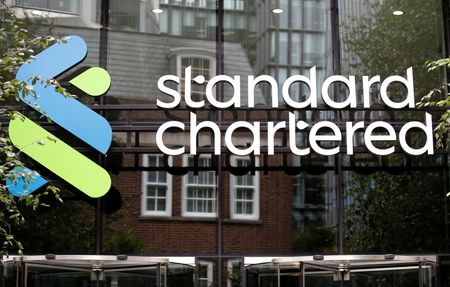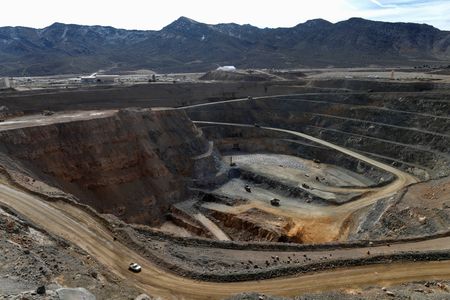By Joe Cash, Ellen Zhang and Kevin Yao
BEIJING (Reuters) -China’s economy slowed less than expected in the second quarter in a show of resilience against U.S. tariffs, though analysts warn that weak demand at home and rising global trade risks will ramp up pressure on Beijing to roll out more stimulus.
The world’s No. 2 economy has so far avoided a sharp slowdown in part due to policy support and as factories took advantage of a U.S.-China trade truce to front-load shipments, but investors are bracing for a weaker second half as exports lose momentum, prices continue to fall, and consumer confidence remains low.
Policymakers face a daunting task in achieving the annual growth target of around 5% – a goal many analysts view as ambitious given entrenched deflation and weak demand at home.
Data on Tuesday showed China’s gross domestic product (GDP) grew 5.2% in the April-June quarter from a year earlier, slowing from 5.4% in the first quarter, but just ahead of analysts’ expectations in a Reuters poll for a rise of 5.1%.
“China achieved growth above the official target of 5% in Q2 partly because of front loading of exports,” said Zhiwei Zhang, chief economist at Pinpoint Asset Management.
“The above target growth in Q1 and Q2 gives the government room to tolerate some slowdown in the second half of the year.”
On a quarterly basis, GDP grew 1.1% in April-June, the National Bureau of Statistics data showed, compared with a forecast 0.9% increase and a 1.2% gain in the previous quarter.
Investors are closely watching for signs of fresh stimulus at the upcoming Politburo meeting due in late July, which is likely to shape economic policy for the remainder of the year.
Beijing has ramped up infrastructure spending and consumer subsidies, alongside monetary easing. In May, the central bank cut interest rates and injected liquidity as part of broader efforts to cushion the economy from U.S. President Donald Trump’s sweeping tariffs.
Some analysts believe the government could ramp up deficit spending if growth slows sharply.
Market reaction to the data was largely muted, with China’s blue-chip CSI300 Index reversing course to trade down 0.1%, while Hong Kong’s benchmark Hang Seng cut gains to trade up 0.7%.
HOUSEHOLDS PRESSURED
Separate June activity data also released on Tuesday underlined the pressure on consumers. While industrial output rose 6.8% year-on-year last month – the fastest pace since March, retail sales growth slowed down to 4.8%, from 6.4% in May and hitting the lowest since January-February.
Indeed, the headline GDP numbers held little sway for most households including 30-year-old doctor Mallory Jiang, in the southern tech hub Shenzhen, who says she and her husband both had pay cuts this year.
“Both our incomes as doctors have decreased, and we still don’t dare buy an apartment. We are cutting back on expenses: commuting by public transport, eating at the hospital cafeteria or cooking at home. My life pressure is still actually quite high.”
China observers and analysts say stimulus alone may not be enough to tackle entrenched deflationary pressures, with producer prices in June falling at their fastest pace in nearly two years.
Zichun Huang, China economist at Capital Economics, said the GDP data “probably still overstate the strength of growth.”
“And with exports set to slow and the tailwind from fiscal support on course to fade, growth is likely to slow further during the second half of this year.”
Data on Monday showed China’s exports regained some momentum in June as factories rushed out shipments to capitalise on the fragile tariff truce between Beijing and Washington ahead of a looming August deadline.
TARIFF, PROPERTY HEADWINDS
The latest Reuters poll projected GDP growth to slow to 4.5% in the third quarter and 4.0% in the fourth, underscoring mounting economic headwinds as Trump’s global trade war leaves Beijing with the tough task of getting households to spend more at a time of uncertainty.
China’s 2025 GDP growth is forecast to cool to 4.6% – falling short of the official goal – from last year’s 5.0% and ease even further to 4.2% in 2026, according to the poll.
China’s property downturn remained a drag on overall growth despite multiple rounds of support measures, with investment in the sector falling sharply in the first six months, while new home prices in June tumbled at the fastest monthly pace in eight months.
China’s top leaders pledged to push forward urban village renovation and quicken a new property development model, state media reported Tuesday.
Fixed-asset investment also grew at a slower-than-expected 2.8% pace in the first six months year-on-year, from 3.7% in January-May.
The softer investment outturn reflected the broader economic uncertainty, with China’s crude steel output in June falling 9.2% from the year before, as more steelmakers carried out equipment maintenance amid seasonally faltering demand.
“Q3 growth is at risk without stronger fiscal stimulus,” said Dan Wang, China director at Eurasia Group in Singapore.
“Both consumers and businesses have turned more cautious, while exporters are increasingly looking overseas for growth.”
(Reporting by Joe Cash, Ellen Zhang and Kevin YaoEditing by Shri Navaratnam)

